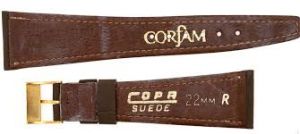Difference between revisions of "Corfam"
(Created page with "==Corfam== Not everything can be successful, even if you have had an enormously successful product like nylon. Corfam is an excellent example of a synthetic product that sim...") |
(→Corfam) |
||
| Line 1: | Line 1: | ||
==Corfam== | ==Corfam== | ||
| − | + | [[File:Corfam strap.jpg|thumb]] | |
Not everything can be successful, even if you have had an enormously successful product like nylon. Corfam is an excellent example of a synthetic product that simply did not live up to its expectations over time for DuPont. | Not everything can be successful, even if you have had an enormously successful product like nylon. Corfam is an excellent example of a synthetic product that simply did not live up to its expectations over time for DuPont. | ||
| Line 13: | Line 13: | ||
DuPont ended making Corfam in 1971, leaving it with only seven years of production. That year, the process for making Corfam was sold to a company in Warsaw, Poland. Also, that year on April 11, 1971, an article in the New York Times referred to Corfam as “DuPont’s $100 Million Edsel”. | DuPont ended making Corfam in 1971, leaving it with only seven years of production. That year, the process for making Corfam was sold to a company in Warsaw, Poland. Also, that year on April 11, 1971, an article in the New York Times referred to Corfam as “DuPont’s $100 Million Edsel”. | ||
| − | Corfam also found its way into many watch straps and was used by many manufacturers. It has a tendancy to decay over time due to its relative inflexiblity and original straps are extremely rare now. It was used notably by Omega for the Dynamic range and Heuer for their sports models. | + | Corfam also found its way into many watch straps and was used by many manufacturers. It has a tendancy to decay over time due to its relative inflexiblity and original straps are extremely rare now. It was used notably by Omega for the Dynamic range and Heuer for their sports models. |
==Links== | ==Links== | ||
[[Watch Straps and Bracelets]] | [[Watch Straps and Bracelets]] | ||
Revision as of 21:53, 9 February 2021
Corfam
Not everything can be successful, even if you have had an enormously successful product like nylon. Corfam is an excellent example of a synthetic product that simply did not live up to its expectations over time for DuPont.
Early in the twentieth century, DuPont began seeking a synthetic replacement for leather. To get them into the business, they purchased the Fabrikoid Company in 1910. Fabrikoid was nitrocellulose-coated cotton fabric which could be made into many objects, but its two biggest uses at the time were in binding books and in the automotive industry.
By the late 1950s, DuPont scientists had created a material that looked like leather, with a high shiny gloss surface, which resembled “patent leather”. Later called Corfam, it consisted of a poromeric material which was made by bonding a plastic like coating to a fiber substrate. Early on, due to its extraordinarily high cost to create and produce, DuPont decided to market this new material primarily in footwear – more specifically for dress shoes, due to its shiny appearance.
By 1962, DuPont had wear-tested around 15,000 shoes with Corfam, made at its pilot plant in Newburgh, New York. Wear-testing was typically done by DuPont employees who agreed to wear the item for a certain amount of time and then answer questions and write up a review. Even though Corfam was pointed towards its use in shoes, other items were made of the material and wear-tested.
Corfam was introduced to the shoe industry during the 1963 Chicago Shoe Show. The public first learned about Corfam on January 27, 1964 and it was also featured at the 1964 New York World’s Fair in the DuPont Pavilion. That year also saw the manufacturing of Corfam moved to a facility in Old Hickory, Tennessee. From 1964 to 1969, around 7.5 million pairs of Corfam shoes were sold, but after then, the market severely declined for several reasons, including the popularity of vinyl shoes. Corfam also had the issue that it did not breathe like real leather, so wearers complained about hot feet. Another problem was fit, because if the wearer did not get an exact fit, Corfam did not stretch like leather does.
DuPont ended making Corfam in 1971, leaving it with only seven years of production. That year, the process for making Corfam was sold to a company in Warsaw, Poland. Also, that year on April 11, 1971, an article in the New York Times referred to Corfam as “DuPont’s $100 Million Edsel”.
Corfam also found its way into many watch straps and was used by many manufacturers. It has a tendancy to decay over time due to its relative inflexiblity and original straps are extremely rare now. It was used notably by Omega for the Dynamic range and Heuer for their sports models.
